Interpreting Circularity. Circular City Representations Concealing Transition Drivers
Abstract
:1. Introduction
1.1. Circular Economy in Theory and Practice
1.2. Circularity and its Spatial Articulation Remain Confusing
1.3. Circularity Is Multi-Scalar, -Dimensional and Place-Specific
1.4. Towards a Circularity Drivers Framework for Spatial Practice
2. Materials and Methods
2.1. Comparative Case Study Research
- Content: The object of study is a realized or unrealized spatial circularity representation.
- Scale: Referring to Sandoval et al.’s definition (see Section 1.1), the object of study is a macro scale project (a site in relation to its larger context, a neighborhood, a city or a region).
- Circularity: The project either literally states circularity or implicitly alludes to circularity through graphical closed resource loops representations.
- The project was initiated in the last ten years.
2.2. Analytical Framework for Urban Metabolism Spatial Practices by Philippe Vandenbroeck
3. Results
3.1. Four Circular City Representations
3.1.1. Reburg
3.1.2. R-Urban
3.1.3. Masdar City
3.1.4. Living Breakwaters
4. Discussion: Comparing Four Circularity Representations
4.1. Interpreting Circularity from Different Sustainability Framings
4.1.1. Objectivist versus Constructivist
- Adopting techno-centric views, emphasizing measures and flows in concepts such as ‘zero waste’, ‘carbon neutrality’, or ‘circular economy’.
- Both cities are ‘new’, meaning they do not take into account any existing contextual parameters.
- This makes them generic and reproducible models for circularity.
- Viewing circular economy from the production and consumption system perspective, they privilege technological and economic dimensions and consider social and environmental dimensions as a result of those.
- They represent circularity coherences in a certain moment, an optimal convergence of technology and economics in Reburg’s case, and the application of an ideal ‘model’ in Masdar City’s case. Proposing utopic visions of circularity at a fixed moment in time, they avoid the question of how existing urban fabrics can transition to circularity and become more resilient.
- The images focus on circularity as a product or result that is ‘finished’ or closed. As synchronic imaginaries, they ignore cities’ temporal dimension, the city as process.
- Both representations articulate emancipatory political positions, acting from within the site to achieve radical change. In a way acting from within the site means setting up a process that is starting from (the critique of) the existing, a dialectic between the existing and needed. R-urban hereby explicitly emphasizes the need to act against reigning capitalist sociotechnical regimes in any European city and community, drastically changing the way that resource flows are governed. Living Breakwaters, on the other hand, reimagines a concrete site and situation, Staten Island’s post-disaster coastal area.
- Both of the projects envision dramatic societal change in the way resource flows, communities, and spaces are interacting. Even though both AAA and Scapestudio label themselves as ‘activist’ spatial practices, R-urban expresses a more radical societal critique than Living Breakwaters, and explicitly constructs alternatives for reigning regimes initiating a post-growth society from the margin. Living Breakwaters, on the other hand, works with transformative powers within existing institutions in a more consensus-driven and pragmatic practice. It tries to shift spatial practices and intergovernmental collaborations from within, explicitly engaging as many actors and stakeholders as possible to achieve resilience, making use of available situational and material resources that it can capture. The continuous reception and appropriation of Living Breakwaters on both community as well as local, state, and federal level since 2013, seem to indicate successful and supported long-term project engagements.
- Both of the projects privilege social, ecological, and cultural dimensions, and consider technology and economy as secondary driving forces.
- The images are dialectic, building new syntheses through images as a method of intellectual investigation supporting dialogue.
4.1.2. Proximity versus Connectivity
4.1.3. Resource Efficiency
4.1.4. Spatial Context Characteristics and Sustainability Transitions Drivers
4.2. Building up a Circularity Drivers Framework for Spatial Practice
4.2.1. Four Circularity Agendas
- A technocratic agenda optimizing flows: Masdar City as industrial-ecological pool table metabolisms, prioritizing resource efficiency, clean technology in sustainable infrastructures conceived from the top down.
- A business-driven agenda innovating with flows: Reburg as ‘smart city’ web metabolisms that are founded on circular economy business models and digital networks.
- A holistic agenda contextualizing flows: Living Breakwaters as bioregional mosaic metabolisms offering a cultural, multi-scalar, and place-specific circularity approach as restoring ecological cycles.
- An activist agenda democratizing flows: R-urban as narrative metabolisms prioritizing bottom-up community stewardship over resource flows supporting a civic economy in a larger resilience strategy.
4.2.2. Circularity Drivers Framework for Spatial Practice
- is systemic: it aims to relate micro, meso and macro scales within an ideal situation of regenerating ecosystems;
- envisions how people relate to the ecosystems they inhabit as part of circularity; and,
- combines both technocratic and emancipatory approaches [66], drawing both from management and politics.
5. Conclusions
5.1. Multi-Dimensional Spatial Circularity Requires Combinations of Different Sustainability Framings
5.2. Spatial Circularity Representations are Implicitly or Explicitly Political
5.3. The Leading Disciplinary Field and Commissioner Determine which Circularity Drivers are Addressed
5.4. Urban Landscape Design can Approach Circularity in an Inclusive, Multi-Dimensional, Place-Specific and Multi-Scalar Way
5.5. Urban Landscape Design Can Act as a Pivot in Transdisciplinary Spatial Circularity Design Research
5.6. An Agenda for Spatial Circularity Assignments
- Forward looking urban landscape design research, in particular places in circular economy transition.
- Open questions and policy frameworks allowing holistic approaches not defending one client in particular, but aiming for resource efficiency integrating material, social, economic and environmental dimensions across political agendas.
- Multi-actor and multilevel support on community, local and higher government levels
- Multidisciplinary design teams integrating industrial ecology, scenario planning, political ecology, and other relevant expertise.
Author Contributions
Acknowledgments
Conflicts of Interest
References
- Korhonen, J.; Cali, N.; Feldman, A.; Seyoum Esthetu, B. Circular economy as an essentially contested concept. J. Clean. Prod. 2018, 175, 544–552. [Google Scholar] [CrossRef]
- Ghisellini, P.; Cialani, C.; Ulgiati, S. A review on circular economy: The expected transition to a balanced interplay of environmental and economic systems. J. Clean. Prod. 2016, 114, 11–32. [Google Scholar] [CrossRef]
- Merli, R.; Preziosi, M.; Acampora, A. How do scholars approach the circular economy? A systematic literature review. J. Clean. Prod. 2018, 178, 703–722. [Google Scholar] [CrossRef]
- Bocken, N.; Olivetti, E.; Cullen, A.; Jonathan, M.; Potting, J.; Lifset, R. Taking the Circularity to the Next Level: A Special Issue on the Circular Economy. J. Ind. Ecol. 2017, 21, 476–482. [Google Scholar] [CrossRef]
- Kirchherr, J.; Reike, D.; Hekkert, M. Conceptualizing the circular economy: An analysis of 114 definitions. Resour. Conserv. Recycl. 2017, 127, 221–232. [Google Scholar] [CrossRef]
- Korhonen, J.; Honkasalo, A.; Seppälä, J. Circular Economy: The Concept and its Limitations. Ecol. Econ. 2018, 143, 37–46. [Google Scholar] [CrossRef]
- Prieto-Sandoval, V.; Jaca, C.; Ormazabal, M. Towards a consensus on the circular economy. J. Clean. Prod. 2018, 179, 605–615. [Google Scholar] [CrossRef]
- Pomponi, F.; Moncaster, A. Circular economy for the built environment: A research framework. J. Clean. Prod. 2017, 143, 710–718. [Google Scholar] [CrossRef]
- Ellen MacArthur Foundation. Towards the Circular Economy Vol. 1. 2013. Available online: https://www.ellenmacarthurfoundation.org/publications/towards-the-circular-economy-vol-1-an-economic-and-business-rationale-for-an-accelerated-transition (accessed on 28 January 2018).
- Ford, H. Learning from waste. In Today and Tomorrow; Productivity Press: Cambridge, MA, USA, 1926; pp. 91–100. [Google Scholar]
- Meadows, D.H.; Meadows, D.L.; Randers, J. The Limits to Growth: A Report for the Club of Rome’s Project on the Predicament of Mankind Meadows, 2nd ed.; Donella, H., Meadows, D., Randers, J., Eds.; New American Library: New York, NY, USA, 1975. [Google Scholar]
- Prendeville, S.; Cherim, E.; Bocken, N. Circular Cities: Mapping Six Cities in Transition. Environ. Innov. Soc. Transit. 2017, 26, 171–194. [Google Scholar] [CrossRef]
- Ellen MacArthur Foundation. Schools of Thought. Available online: https://www.ellenmacarthurfoundation.org/circular-economy/schools-of-thought (accessed on 13 March 2018).
- Ellen MacArthur Foundation. Delivering the Circular Economy: A Toolkit for Policymakers. Available online: https://www.ellenmacarthurfoundation.org/publications/delivering-the-circular-economy-a-toolkit-for-policymakers (accessed on 13 March 2018).
- Arnsperger, C.; Bourg, D. Vers une économie authentiquement circulaire. Revue de l’OFCE 2016, 145, 91–125. [Google Scholar] [CrossRef]
- McDowall, W.; Geng, Y.; Huang, B.; Barteková, E.; Bleischwitz, R.; Türkeli, S.; Kemp, R.; Doménech, T. Circular Economy Policies in China and Europe. J. Ind. Ecol. 2017, 21, 651–661. [Google Scholar] [CrossRef]
- European Commission. Closing the Loop: An EU Action Plan for the Circular Economy. 2015. Available online: http://eur-lex.europa.eu/legal-content/EN/TXT/?uri=CELEX:52015DC0614 (accessed on 13 March 2018).
- Ellen MacArthur Foundation. Circular Cities Network. Available online: https://www.ellenmacarthurfoundation.org/news/circular-cities-network (accessed on 13 March 2018).
- Municipality of Amsterdam. Sustainable Amsterdam, Agenda for Renewable Energy, Clear Air, a Circular Economy and A climate-Resilient City; Municipality of Amsterdam: Amsterdam, The Netherlands, 2015; 76p, Available online: http://urbantransform.eu/wp-content/uploads/sites/2/2013/02/Sustainable_Amsterdam_27-3-2015.pdf (accessed on 20 April 2018).
- Van Winden, W.; Oskam, I.; Van den Buuse, D.; Schrama, W.; Van Dijck, E.J. Organising Smart City Projects: Lessons from Amsterdam; Hogeschool van Amsterdam: Amsterdam, The Netherlands, 2016; 126p, Available online: http://www.hva.nl/carem/gedeelde-content/publicaties/publicaties-algemeen/2016/organising-smart-city-projects.html (accessed on 20 April 2018).
- Glasgow Chamber of Commerce; Zero Waste Scotland; Glasgow City Council; Circle Economy. Circular Glasgow: A Vision and Action Plan for the City of Glasgow; Glasgow Chamber of Commerce, 2016; 31p. Available online: https://www.circle-economy.com/wp-content/uploads/2016/06/circular-glasgow-report-web-low-res.pdf (accessed on 20 April 2018).
- Mairie de Paris. Une économie sociale et solidaire. In Livre Blanc de l’économie circulaire du Grand Paris; ADEME: Marseille, France, 2015; Available online: https://api-site-cdn.paris.fr/images/75577 (accessed on 10 April 2018).
- Ellen MacArthur Foundation. Cities in the Circular Economy: An Initial Exploration. 2017. Available online: https://www.ellenmacarthurfoundation.org/publications/cities-in-the-circular-economy-an-initial-exploration (accessed on 28 January 2018).
- Vandenbroeck, P. Working with Wicked Problems; The King Baudouin Foundation: Brussels, Belgium, 2012; 50p. [Google Scholar]
- Loorbach, D.; Rotmans, J. Transities & Transitiemanagement. Oorsprong, Status en Toekomst; Drift: Rotterdam, The Netherlands, 2012; 8p. [Google Scholar]
- Bugge, M.; Capasso, M.; Finne, H.; Hansen, T.; Klitkou, A.; Normann, H.; Steen, M. Geography of Sustainability Transitions. In Proceedings of the 4th Geography of Innovation Conference, Barcelona, Spain, 31 January–2 February 2018; Available online: http://geoinno2018.com/geography-of-sustainability-transitions/ (accessed on 28 January 2018).
- Coenen, L.; Benneworth, P.; Truffer, B. Toward a spatial perspective on sustainability transitions. Res. Policy 2012, 41, 968–979. [Google Scholar] [CrossRef]
- Groat, L.N.; Wang, D. Architectural Research Methods; Monacelli: New York, NY, USA, 2002. [Google Scholar]
- Shuttleworth, M. Case Study Research Design. 2008. Available online: https://explorable.com/case-study-research-design (accessed on 16 March 2018).
- Yin, R.K. Case Study Research: Design and Methods, 2nd ed.; Sage Publications: Thousand Oaks, CA, USA, 1991; ISBN 0-8039-3470-X. [Google Scholar]
- Rittel, H.; Webber, M.M. Dilemmas in a General Theory of Planning. Policy Sci. 1973, 4, 155–169. [Google Scholar] [CrossRef]
- Viganò, P. Les Territoires de l’urbanisme, le Projet Comme Producteur de Connaissance; Metis Presses: Paris, France, 2014; ISBN 978-2-940406-61-6. [Google Scholar]
- Vandenbroeck, P. Whither Urban Metabolism. In Urban Design Strategies; KU Leuven: Leuven, Belgium, 2017. [Google Scholar]
- Vandenbroeck, P. Een Metabolische Manier van naar de Wereld Te Kijken; Labo Ruimte: Brussels, Belgium, 2017; unpublished. [Google Scholar]
- Atelier Brussels. Three Designing with Flows Masterclasses. Available online: http://www.architectureworkroom.eu/atelierbrussel/masterclass-designing-with-flows (accessed on 28 January 2018).
- Vandenbroeck, P. Designing with flows. In Towards an Urban-Metabolic Agenda for a Circular Future; OVAM, FABRIC, VMM, Team Vlaams Bouwmeester and Metabolism of Cities: Brussels, Belgium, 2017; 25p. [Google Scholar]
- OVAM, Stand van zaken Vlaams Materialenprogramma. Clusters en randvoorwaarden. Available online: https://www.vlaanderen.be/nl/publicaties/detail/stand-van-zaken-vlaams-materialenprogramma-clusters-en-randvoorwaarden (accessed on 15 March 2018).
- Baccini, P.; Brunner, P. Metabolism of the Anthroposphere: Analysis, Evaluation, Design, 2nd ed.; The MIT Press: Cambridge, MA, USA, 2012; ISBN 978-0-262-01665-0. [Google Scholar]
- Castan Broto, V.; Allen, A.; Rapoport, E. Interdisciplinary Perspectives on Urban Metabolism. J. Ind. Ecol. 2012, 16, 851–861. [Google Scholar] [CrossRef]
- Matutinović, I. An Institutional Approach to Sustainability: Historical Interplay of Worldviews, Institutions and Technology. J. Econ. Issues 2007, 41, 1109–1137. [Google Scholar] [CrossRef]
- Beinfield, H.; Korngold, E. Handboek Chinese Geneeswijzen: Theorie, Typologie en Therapie, 7th ed.; Altamira11: Haarlem, The Netherlands, 2016; ISBN 9789401302418. [Google Scholar]
- Vlaanderen Circulair. Samen Werken aan Circulaire Economie in Vlaanderen. Available online: http://www.vlaanderen-circulair.be/nl (accessed on 28 January 2018).
- Pantopicon. Welcome to Reburg—The Circular City. Available online: http://pantopicon.be/portfolio/welcome-to-reburg-the-circular-city/ (accessed on 28 January 2018).
- Plan C, Pantopicon, Welcome to Reburg. Available online: www.reburg.world (accessed on 28 January 2018).
- R-urban, About R-urban. Available online: http://r-urban.net/en/sample-page/ (accessed on 28 January 2018).
- Hopkins, R. The Transition Handbook: From Oil Dependency to Local Resilience; Hopkins, R., Ed.; Foxhole Green Books: Foxhole, UK, 2008; ISBN 9781900322188. [Google Scholar]
- Petcou, C.; Petrescu, D. R-urban Resilience. In Atlas Geography Architecture and Change in an Interdependent World; Yszczuk, R., Smith, J., Clark, N., Butcher, M., Eds.; Black Dog Publishing: London, UK, 2011; ISBN 1-907317-39-2. [Google Scholar]
- Atelier d’Architecture Autogérée. Available online: www.urbantactics.org (accessed on 28 January 2018).
- Le Parisien, L’Agrocité déménagée de force de Colombes vers Gennevilliers. Available online: http://www.leparisien.fr/colombes-92700/l-agrocite-demontee-de-force-a-colombes-20-02-2017-6695853.php (accessed on 28 January 2018).
- Telerama. A Colombes, l’écologie citoyenne perd une bataille (mais pas la guerre). Available online: http://www.telerama.fr/sortir/a-colombes-l-ecologie-citoyenne-perd-une-bataille-mais-pas-la-guerre,155117.php (accessed on 28 January 2018).
- Masdar City. Available online: https://en.wikipedia.org/wiki/Masdar (accessed on 28 January 2018).
- Veolia. Masdar City, a Zero-Waste, Zero-Carbon City in the Desert. Available online: http://www.livingcircular.veolia.com/en/lifestyle/masdar-city-zero-waste-and-zero-carbon-desert (accessed on 28 January 2018).
- Masdar City © Foster + Partners. Available online: https://www.fosterandpartners.com/projects/masdar-city/ (accessed on 23 April 2018).
- The Guardian, Masdar’s Zero-Carbon Dream Could Become World’s First Green Ghost Town. Available online: https://www.theguardian.com/environment/2016/feb/16/masdars-zero-carbon-dream-could-become-worlds-first-green-ghost-town (accessed on 28 January 2018).
- Scapestudio. Living Breakwaters Competition. Available online: http://www.scapestudio.com/projects/living-breakwaters-competition/ (accessed on 28 January 2018).
- Rebuild by Design in partnership with 100 resilient cities. Available online: http://rebuildbydesign.org/ (accessed on 28 January 2018).
- The NY Governor’s Office of Storm Recovery New York. Available online: https://stormrecovery.ny.gov/LBWCAC (accessed on 28 January 2018).
- Transitienetwerk Middenveld. Toekomstvisie. Available online: http://www.transitienetwerkmiddenveld.be/over-ons/toekomstvisie (accessed on 28 January 2018).
- Transitienetwerk Middenveld, Betergem. Available online: http://www.transitienetwerkmiddenveld.be/157-een-gelukkig-2038-gewenst (accessed on 28 January 2018).
- Barles, S. Society, energy and materials: The contribution of urban metabolism studies to sustainable urban development issues. J. Environ. Plan. Manag. 2010, 53, 439–455. [Google Scholar] [CrossRef]
- The Guardian, Reaching New Heights. Available online: https://www.theguardian.com/environment/2008/jan/30/carbonemissions.climatechange (accessed on 28 January 2018).
- Bélanger, P. Landscape Infrastructure. Urbanism beyond Engineering; Wageningen University: Wageningen, The Netherlands, 2013; p. 407. [Google Scholar]
- Antoniou, V. City as an Organism: Paradigms for the Practice of Urban Design. Available online: https://www.scribd.com/document/97432027/City-as-an-Organism (accessed on 16 March 2018).
- Orff, K. Toward an Urban Ecology; The Monacelli Press: New York, NY, USA, 2016; 272p, ISBN 9781580934367. [Google Scholar]
- Cugurullo, F. Urban eco-modernisation and the policy context of new eco-city projects: Where Masdar City fails and why. Urban Stud. 2016, 53, 2417–2433. [Google Scholar] [CrossRef]
- Kampelmann, S. On the circularization of territorial metabolism. In Designing Territorial Metabolism: Metropolitan Studio on Brussels, Barcelona, and Veneto; Grulois, G., Tosi, M.C., Crosas, C., Eds.; Jovis: Berlin, Germany, 2018. [Google Scholar]
- Krieger, A. Where and How Does Urban Design Happen? In Urban Design; Krieger, A., Saunders, W., Eds.; University of Minnesota Press: Minneapolis, MN, USA, 2003. [Google Scholar]
- Urban Design. Condensed Report of an Invitation Conference Sponsored by Faculty and Alumni Association of Graduate School of Design, Harvard University, April 9–10, 1956. Progress. Archit. 1956, 8, 97–112. [Google Scholar]
- McHarg, I. Design with Nature, xth ed.; John Wiley & Sons, Inc.: New York, NY, USA, 1992; ISBN 9780471114604. [Google Scholar]
- Corner, J. Terra fluxus. In Landscape Urbanism Reader; Waldheim, C., Ed.; Princeton Architectural Press: New York, NY, USA, 2006. [Google Scholar]
- Delva Landscape Architects, Studioninedots, Metabolic. Circular Cities—Designing post-Industrial Amsterdam—The Case of Buiksloterham. Available online: https://issuu.com/delvalandscape/docs/circularcities_designing_post_indus/55 (accessed on 15 March 2018).
- Sijmons, D. Landscape and Energy: Designing Transition; Sijmons, D., Ed.; nai010: Rotterdam, The Netherlands, 2014; 432p, ISBN 97-94-6208-113-0. [Google Scholar]

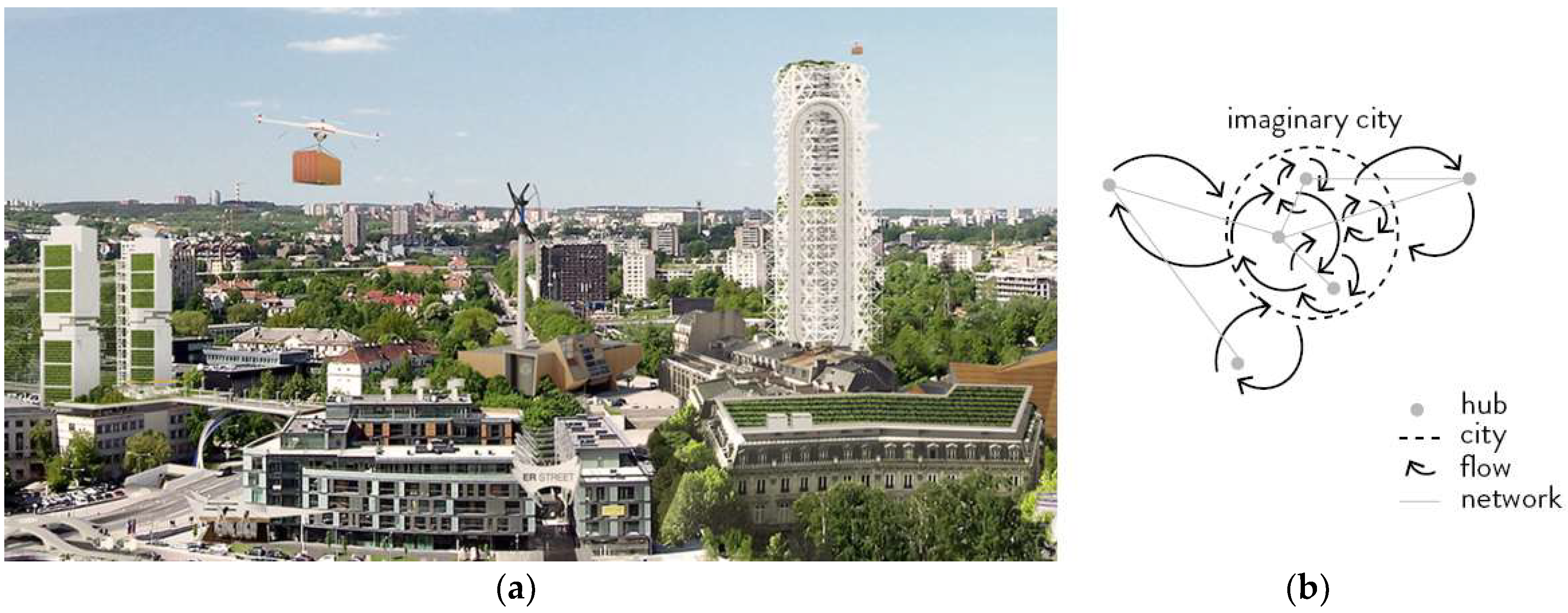
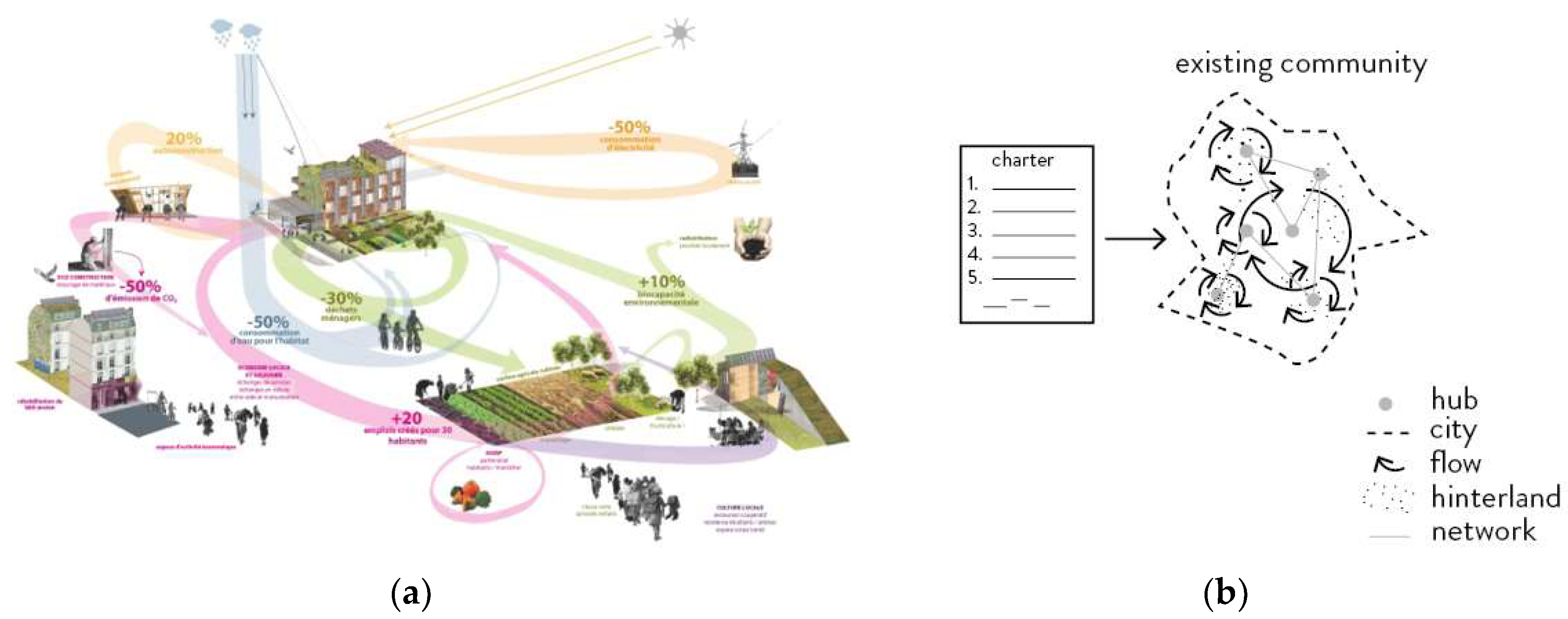
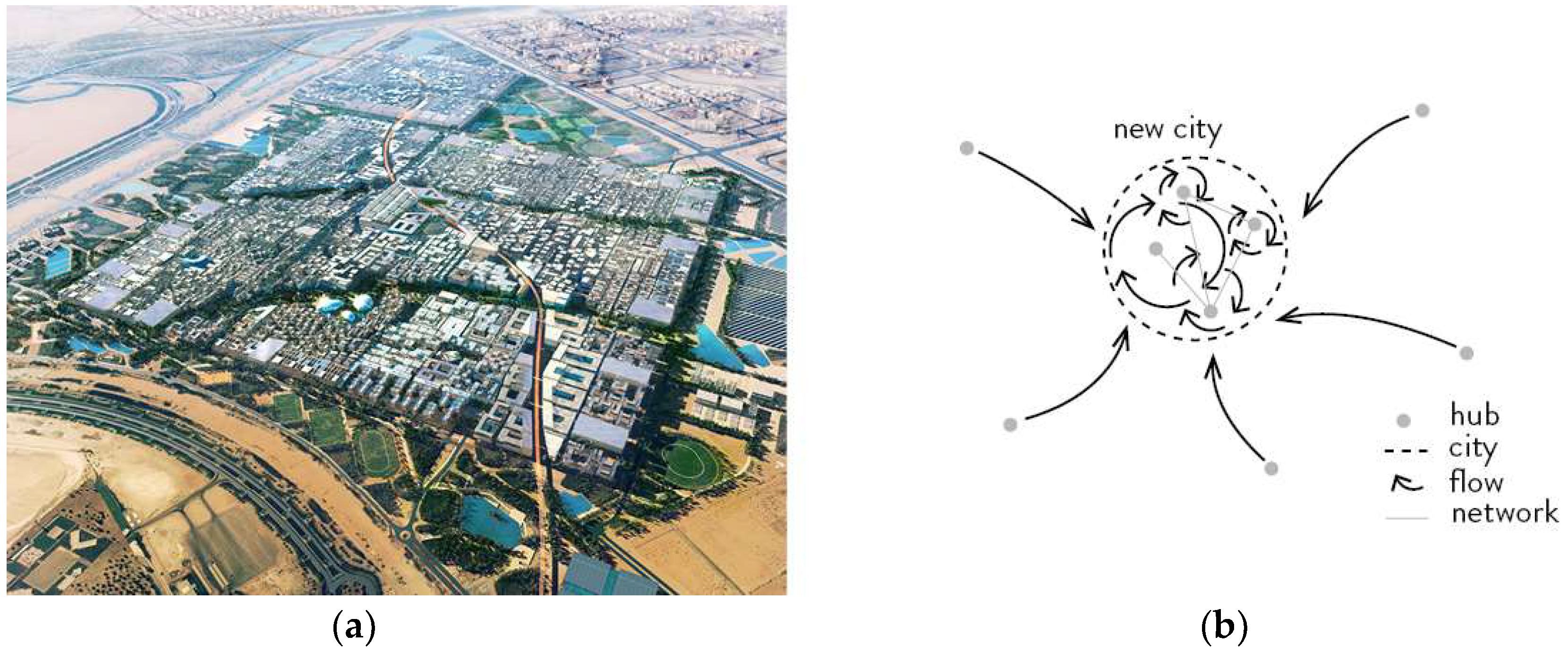
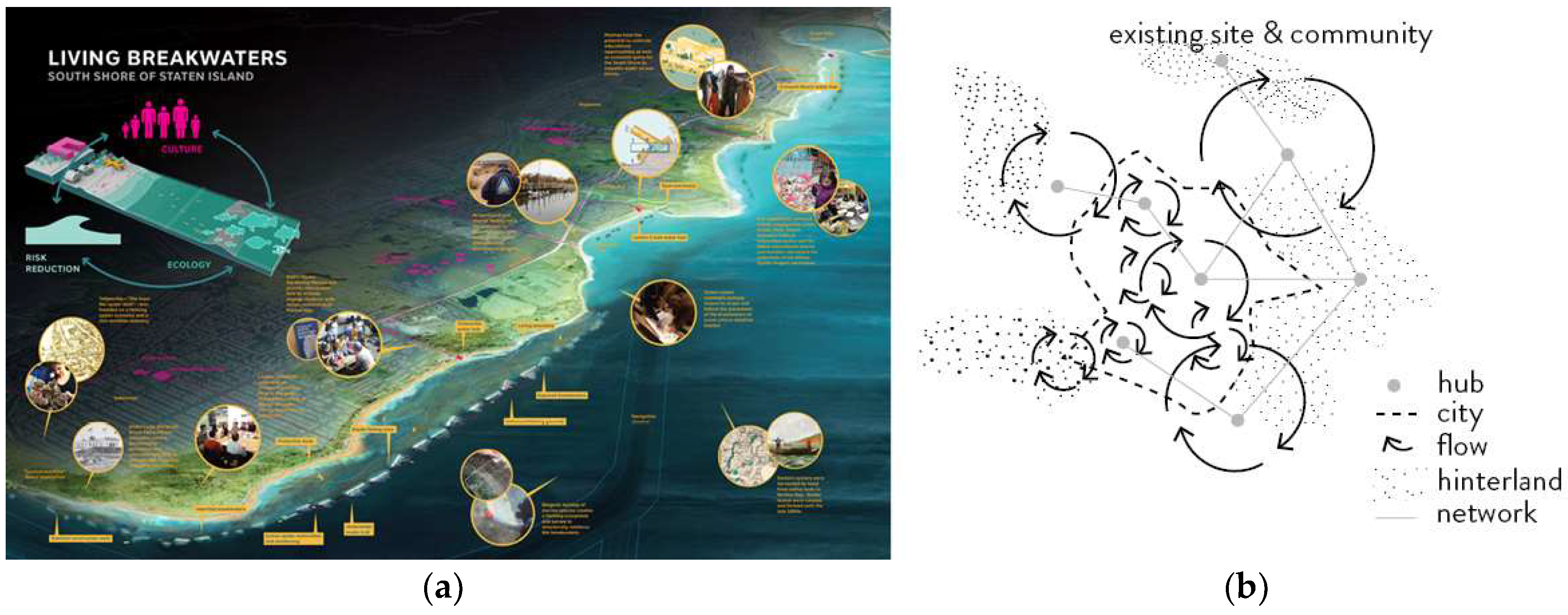
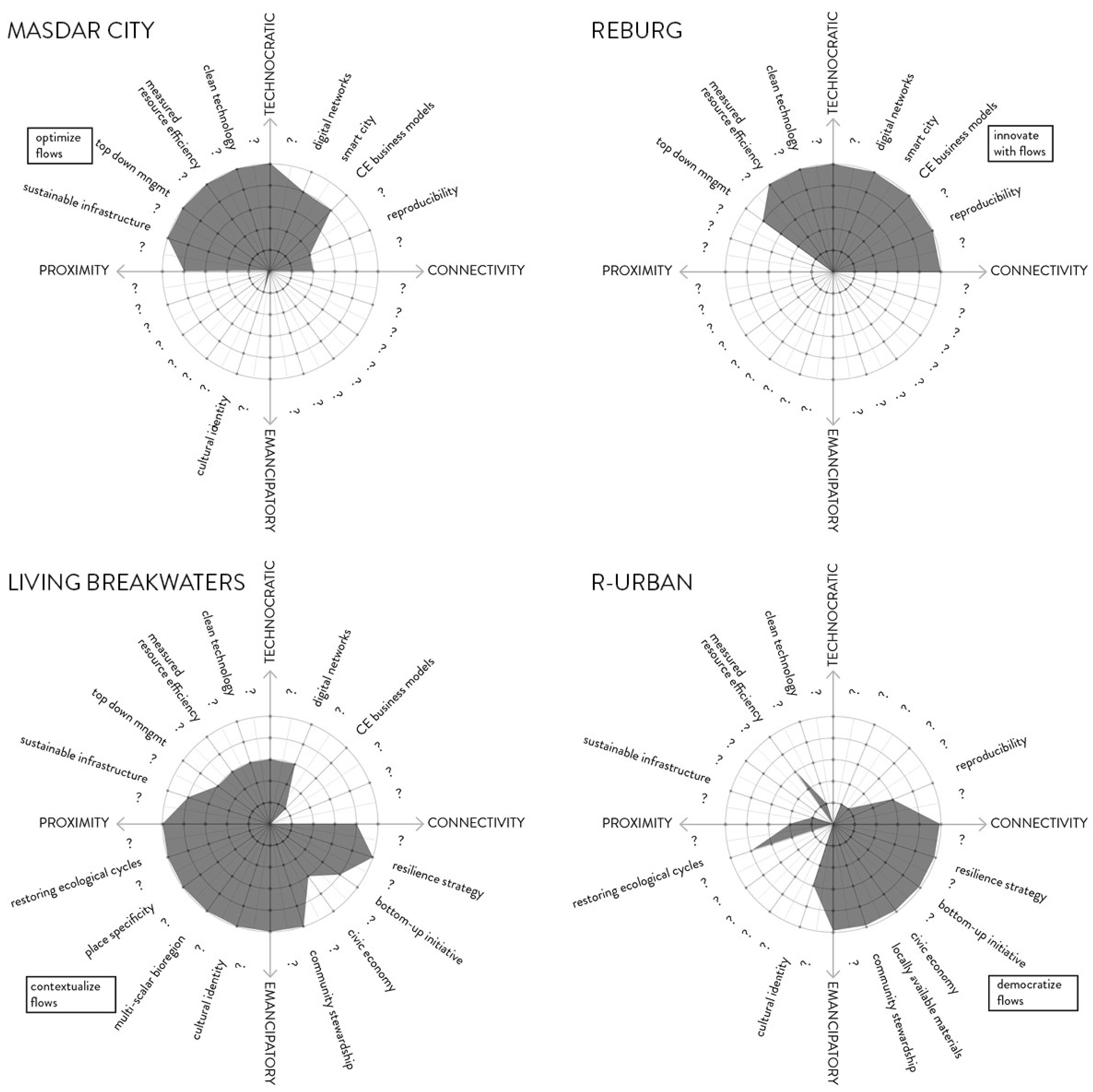
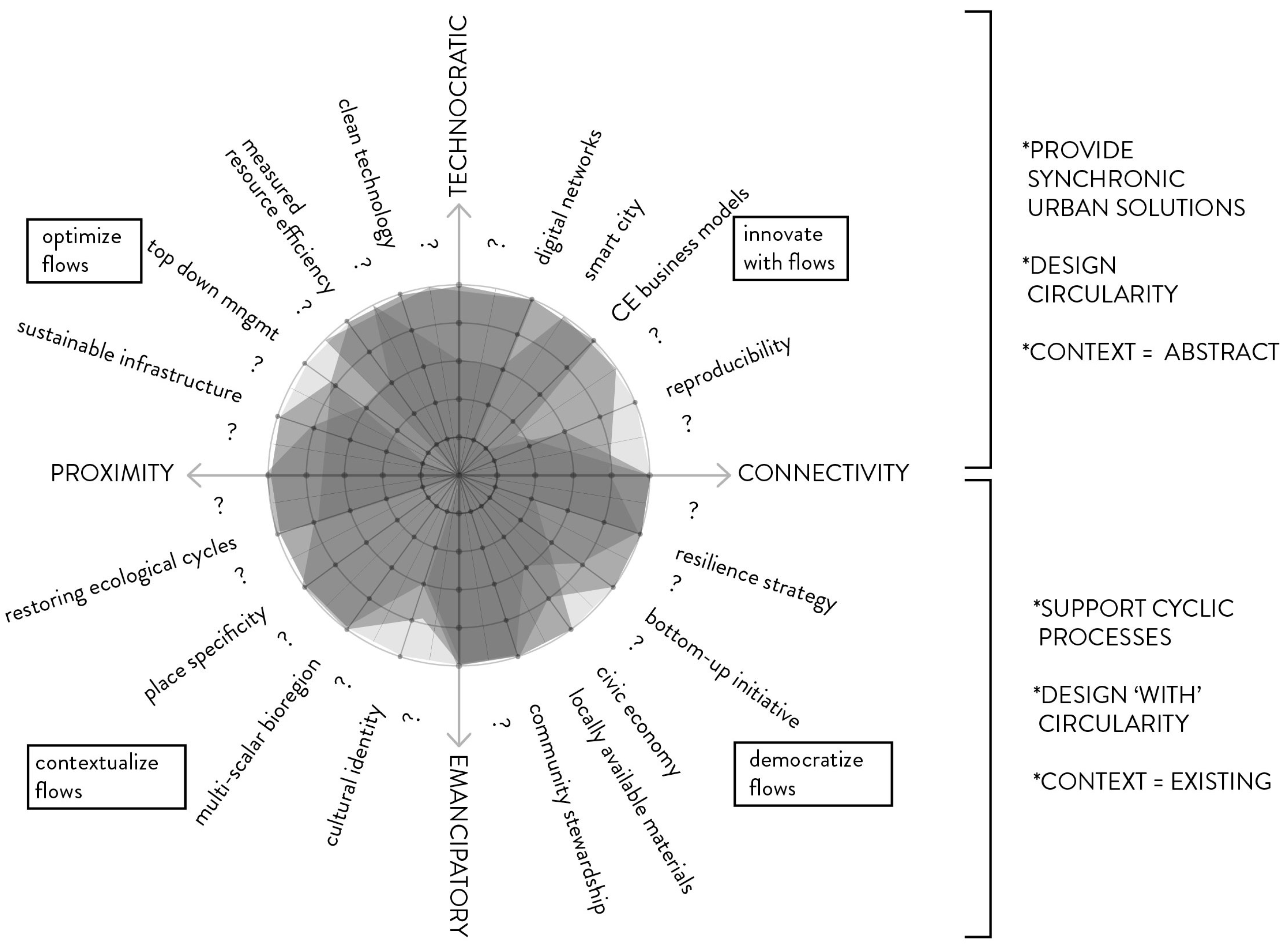
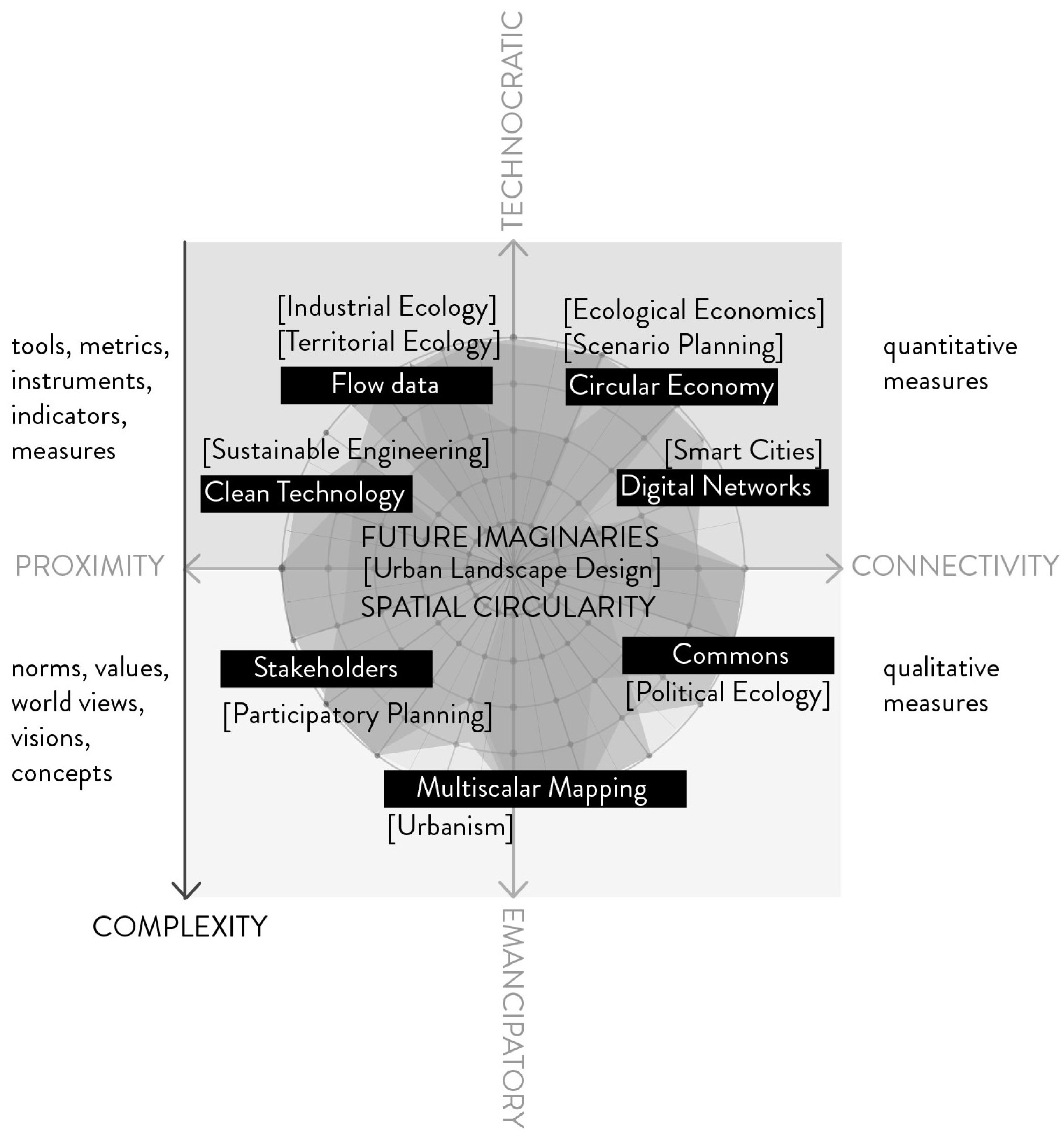
| Reburg | R-Urban | Masdar City | Living Breakwaters | |
|---|---|---|---|---|
| Project question | Imaginary of Circular Flanders in 2036 | Bottom-up urban resilience strategy | First zero waste, zero carbon, fossil fuel free city | Strategic spatial vision to rebuild Staten Island shore |
| Location | Somewhere in Flanders | Anywhere, with pilot project in Colombes, Paris | The desert 17 km outside Abu Dhabi | Staten Island shore, New York City |
| Scale | City | Neighborhood | City | Neigborhood-City-Region |
| Circularity interpretation | Urban solutions for circular economies | Production of commons | Net zero environmental impact | Integrating risk reduction, ecology and culture |
| Main agenda | Circular Economy | Political Change | Resource efficiency | Site and context specific resilience |
| Goal | Provoke out-of-the-box thinking | Inspire/Activate to change the reigning capitalist sociotechnical regime | Demonstrate a global example of circular cities | Guide the creation of resilient shore communities and landscapes |
| Commissioner | Plan C | Community-initiated (by AAA in the case of Colombes) | Abu Dhabi Renewable Energy Company (Masdar) | President Obama’s Hurricane Sandy Rebuilding Task Force |
| Policy context | Circular Economy Transition | Activism | Sustainability transition | Post-disaster recovery and resilience |
| Executer | Pantopicon 2015 | Atelier d’Architecture Autogérée (AAA) since 2008 | (phase one) Foster +Partners et al. 2007–2014 | Scapestudio et al. since 2013 |
| Main Disciplinary field | Scenario planning | Political Ecology and Architecture | Industrial Ecology | Urban Landscape Design |
| Site-visits and semi-structured interviews | Oct 2016 participant in Reburg workshop ‘community meeting 2037’ | Feb 2015, site visits Recyclab and Agrocité, lecture by and discussion with project visionary and architect | Oct 2015, site visit and guided tour as part of Abu Dhabi Ecocity World Summit 2015 | 2013, urban designer at Scapestudio during the project’s design phase. Not personally involved in the project |
© 2018 by the authors. Licensee MDPI, Basel, Switzerland. This article is an open access article distributed under the terms and conditions of the Creative Commons Attribution (CC BY) license (http://creativecommons.org/licenses/by/4.0/).
Share and Cite
Marin, J.; De Meulder, B. Interpreting Circularity. Circular City Representations Concealing Transition Drivers. Sustainability 2018, 10, 1310. https://doi.org/10.3390/su10051310
Marin J, De Meulder B. Interpreting Circularity. Circular City Representations Concealing Transition Drivers. Sustainability. 2018; 10(5):1310. https://doi.org/10.3390/su10051310
Chicago/Turabian StyleMarin, Julie, and Bruno De Meulder. 2018. "Interpreting Circularity. Circular City Representations Concealing Transition Drivers" Sustainability 10, no. 5: 1310. https://doi.org/10.3390/su10051310
APA StyleMarin, J., & De Meulder, B. (2018). Interpreting Circularity. Circular City Representations Concealing Transition Drivers. Sustainability, 10(5), 1310. https://doi.org/10.3390/su10051310





